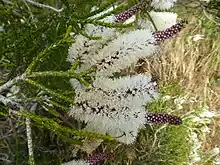| Chenille honey-myrtle | |
|---|---|
 | |
| Melaleuca huegelii | |
| Scientific classification | |
| Kingdom: | Plantae |
| Clade: | Tracheophytes |
| Clade: | Angiosperms |
| Clade: | Eudicots |
| Clade: | Rosids |
| Order: | Myrtales |
| Family: | Myrtaceae |
| Genus: | Melaleuca |
| Species: | M. huegelii |
| Binomial name | |
| Melaleuca huegelii | |
| Synonyms[1] | |
|
Myrtoleucodendron huegelii (Endl.) Kuntze | |
Melaleuca huegelii, commonly known as chenille honey-myrtle, is a plant in the myrtle family, Myrtaceae and is endemic to the south-west coastal areas of Western Australia. It has small, almost scale-like leaves and flower spikes sometimes more than 100 millimetres (4 in) long on the ends many of its branches.
Description
Melaleuca huegelii is a large shrub, sometimes a small tree up to 5 m (20 ft) tall, with dark-coloured bark and branches that are usually covered with fine, soft hairs, at least when young. Its leaves are 1.3–10 mm (0.05–0.4 in) long, 1–2.5 mm (0.04–0.1 in) wide, roughly egg-shaped and taper to a point.[2][3]
The flowers are white, cream-coloured or a shade of pink and arranged in spikes on the ends of branches which continue to grow after flowering and sometimes also in the upper leaf axils. The spikes are up to 100 mm (4 in) long and sometimes longer, up to 25 mm (1 in) in diameter and contain up to 140 groups of flowers in threes. The petals are 1.5–3 mm (0.06–0.1 in) long and fall off as the flowers age. The stamens are arranged in bundles of five around the flower, with 6 to 13 stamens in each bundle. Flowering occurs between August and January and is followed by fruit which are woody, cup-shaped capsules 2.3–2.8 mm (0.09–0.1 in) long and wide in clusters along the stem.[2][3]
.JPG.webp)
.JPG.webp)
Taxonomy and naming
Melaleuca huegelii was first formally described in 1837 by Stephan Endlicher in Enumeratio plantarum quas in Novae Hollandiae ora austro-occidentali ad fluvium Cygnorum et in sinu Regis Georgii collegit Carolus Liber Baro de Hügel.[4][5] The specific epithet (huegelii) refers to Carl von Huegel, collector of the type specimen, who found the species growing at Fremantle in 1833.[2]
There are two subspecies:
- Melaleuca huegelii Endl. subsp. huegelii occurs from the Walkaway district to the Augusta district[2] in the Geraldton Sandplains, Jarrah Forest, Swan Coastal Plain and Warren biogeographic regions;[6][7]
- Melaleuca huegelii subsp. pristicensis Barlow occurs in the Shark Bay district[2] in the Yalgoo biogeographical region.[8][9] The name pristicensis is from the Ancient Greek pristis meaning "shark"[10] in reference to the distribution of the subspecies.[2]
Distribution and habitat
Melaleuca huegelii occurs along the coast of Western Australia from the Shark Bay district to the Augusta district.[2] It occurs in coastal areas on limestone cliffs, dunes and plains.[11][12]
Conservation status
This species is classified as "not threatened" by the Government of Western Australia Department of Parks and Wildlife[11] although the subspecies pristicensis is classified as "Priority Three"[8] meaning that it is poorly known and known from only a few locations but is not under imminent threat.[13]
References
- 1 2 " Melaleuca huegelii". Plants of the World Online. Retrieved 30 August 2021.
- 1 2 3 4 5 6 7 Brophy, Joseph J.; Craven, Lyndley A.; Doran, John C. (2013). Melaleucas : their botany, essential oils and uses. Canberra: Australian Centre for International Agricultural Research. pp. 198–199. ISBN 9781922137517.
- 1 2 Holliday, Ivan (2004). Melaleucas : a field and garden guide (2nd ed.). Frenchs Forest, N.S.W.: Reed New Holland Publishers. pp. 140–141. ISBN 1876334983.
- ↑ Endlicher, Stephan (1837). Enumeratio plantarum quas in Novae Hollandiae ora austro-occidentali ad fluvium Cygnorum et in sinu Regis Georgii collegit Carolus Liber Baro de Hügel. Vindobonae. pp. 48–49. Retrieved 11 May 2015.
- ↑ "Melaleuca huegelii". APNI. Retrieved 11 May 2015.
- ↑ "Melaleuca huegelii subsp. huegelii". FloraBase. Western Australian Government Department of Biodiversity, Conservation and Attractions.
- ↑ "Melaleuca huegelii subsp. huegelii". APNI. Retrieved 11 May 2015.
- 1 2 "Melaleuca huegeliisubsp. pristicensis". FloraBase. Western Australian Government Department of Biodiversity, Conservation and Attractions.
- ↑ "Melaleuca huegelii subsp. pristicensis". APNI. Retrieved 11 May 2015.
- ↑ "Sawtooth shark". Florida Museum of natural History. Retrieved 11 May 2015.
- 1 2 "Melaleuca huegelii". FloraBase. Western Australian Government Department of Biodiversity, Conservation and Attractions.
- ↑ Paczkowska, Grazyna; Chapman, Alex R. (2000). The Western Australian flora : a descriptive catalogue. Perth: Wildflower Society of Western Australia. p. 394. ISBN 0646402439.
- ↑ "Conservation codes for Western Australian Flora and Fauna" (PDF). Government of Western Australia Department of Parks and Wildlife. Retrieved 31 March 2020.